乳腺癌术中放疗中使用x线片进行剂量测定的观察性验证研究
IF 1.8
3区 工程技术
Q3 CHEMISTRY, INORGANIC & NUCLEAR
引用次数: 0
摘要
背景与目的乳腺癌术中放疗(IORT)是传统外束放疗的一种有希望的替代方法,在手术过程中直接向肿瘤床输送高剂量辐射。然而,准确的剂量测定对于确保该手术的安全性和有效性至关重要。本研究旨在开发和验证一种可靠的剂量测定方法,使用GAFchromic EBT-3薄膜在IORT期间进行精确的体内和体外剂量测定。主要目的是验证使用GAFchromic EBT-3薄膜在IORT期间吸收递送剂量的准确性,并与蒙特卡罗模拟进行比较。方法本观察性研究纳入38例在台湾高雄市大同医院及高雄医科大学忠浩纪念医院行IORT的乳腺癌患者。根据预先确定的纳入标准选择患者。在IORT期间,使用GAFchromic EBT-3薄膜,在不同临界点测量吸收剂量,包括涂抹器表面,切除伤口和周围乳房组织。进行蒙特卡罗模拟以验证这些制造商提供的数据的准确性。结果平均测量剂量为20.37±0.67 Gy,与计划剂量20 Gy相差1.2%。其他周围组织的剂量测量显示有效保护,切除伤口的平均剂量为1.36±0.92 Gy,周围乳房边缘的平均剂量为1.08±1.18 Gy。蒙特卡罗模拟证实了与制造商数据的高度一致性,误差范围为3%。结论采用GAFchromic EBT-3薄膜进行IORT剂量测定是可行、可靠的,为保证准确给药提供了独立的验证方法。该研究表明,准确的剂量学验证支持术中放疗(IORT)的临床优化,实现精确的剂量传递,同时减少对周围健康组织的暴露。这些发现可能有助于提高保乳治疗的安全性,改善局部控制和良好的美容效果。需要进一步的研究来完善这项技术,并探索其在其他放射治疗环境中的适用性。本文章由计算机程序翻译,如有差异,请以英文原文为准。
Observational validation study of dosimetry using radiographic films in breast cancer intraoperative radiotherapy
Background and purpose
Intraoperative radiotherapy (IORT) for breast cancer offers a promising alternative to conventional external beam radiotherapy by delivering high-dose radiation directly to the tumor bed during surgery. However, accurate dosimetry is critical to ensure the safety and efficacy of this procedure. This study aimed to develop and validate a reliable dosimetry using GAFchromic EBT-3 films for precise in vivo and in vitro dosimetry during IORT. The primary objective was to verify the accuracy of absorbed delivered doses during IORT using GAFchromic EBT-3 films, in comparison with that of Monte Carlo simulations.
Methods
This observational study included 38 patients with breast cancer who underwent IORT at Kaohsiung Municipal Ta-Tung Hospital and Kaohsiung Medical University Chung-Ho Memorial Hospital in Taiwan. Patients were selected based on predefined inclusion criteria. Using GAFchromic EBT-3 films during IORT, absorbed doses, including the applicator surface, excision wound, and surrounding breast tissue, were measured at various critical points. Monte Carlo simulations were conducted to validate the accuracy of these manufacturer-provided data.
Results
The mean measured dose was 20.37 ± 0.67 Gy, which had a 1.2 % discrepancy from the planned dose of 20 Gy. Dose measurements at other surrounding tissues indicated effective protection, with mean doses of 1.36 ± 0.92 Gy on the excision wound and 1.08 ± 1.18 Gy on the surrounding breast edge. Monte Carlo simulations confirmed a high level of consistency with the manufacturer's data, with an error margin of <3 %.
Conclusions
The use of GAFchromic EBT-3 films for dosimetry during IORT was feasible and reliable and provided an independent verification method to ensure accurate dose delivery. This study demonstrates that accurate dosimetric validation supports the clinical optimization of intraoperative radiotherapy (IORT), enabling precise dose delivery while reducing exposure to surrounding healthy tissues. These findings may contribute to enhanced treatment safety, improved local control, and favorable cosmetic outcomes in breast-conserving therapy. Further research is warranted to refine this technique and explore its applicability in other radiotherapy contexts.
求助全文
通过发布文献求助,成功后即可免费获取论文全文。
去求助
来源期刊

Applied Radiation and Isotopes
工程技术-核科学技术
CiteScore
3.00
自引率
12.50%
发文量
406
审稿时长
13.5 months
期刊介绍:
Applied Radiation and Isotopes provides a high quality medium for the publication of substantial, original and scientific and technological papers on the development and peaceful application of nuclear, radiation and radionuclide techniques in chemistry, physics, biochemistry, biology, medicine, security, engineering and in the earth, planetary and environmental sciences, all including dosimetry. Nuclear techniques are defined in the broadest sense and both experimental and theoretical papers are welcome. They include the development and use of α- and β-particles, X-rays and γ-rays, neutrons and other nuclear particles and radiations from all sources, including radionuclides, synchrotron sources, cyclotrons and reactors and from the natural environment.
The journal aims to publish papers with significance to an international audience, containing substantial novelty and scientific impact. The Editors reserve the rights to reject, with or without external review, papers that do not meet these criteria.
Papers dealing with radiation processing, i.e., where radiation is used to bring about a biological, chemical or physical change in a material, should be directed to our sister journal Radiation Physics and Chemistry.
 求助内容:
求助内容: 应助结果提醒方式:
应助结果提醒方式:


